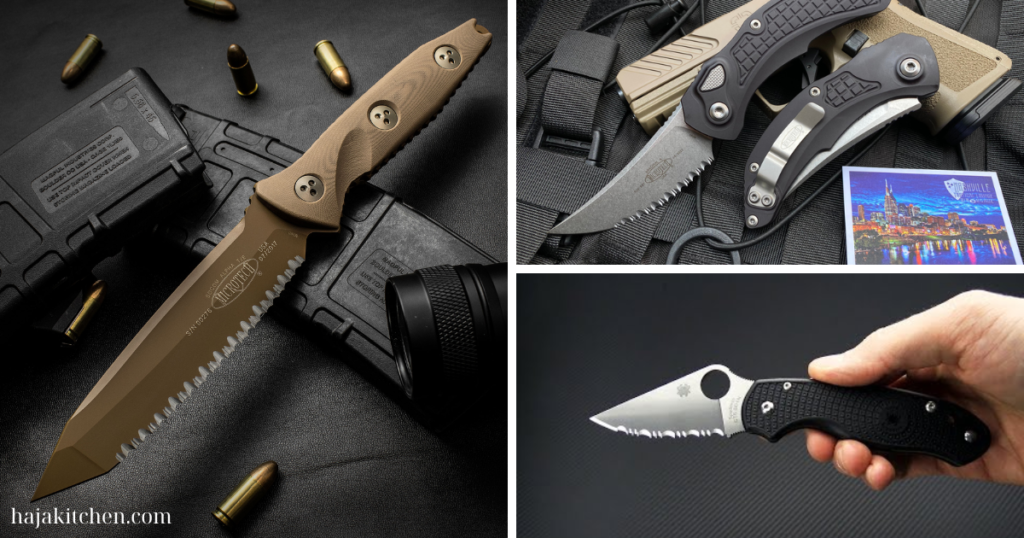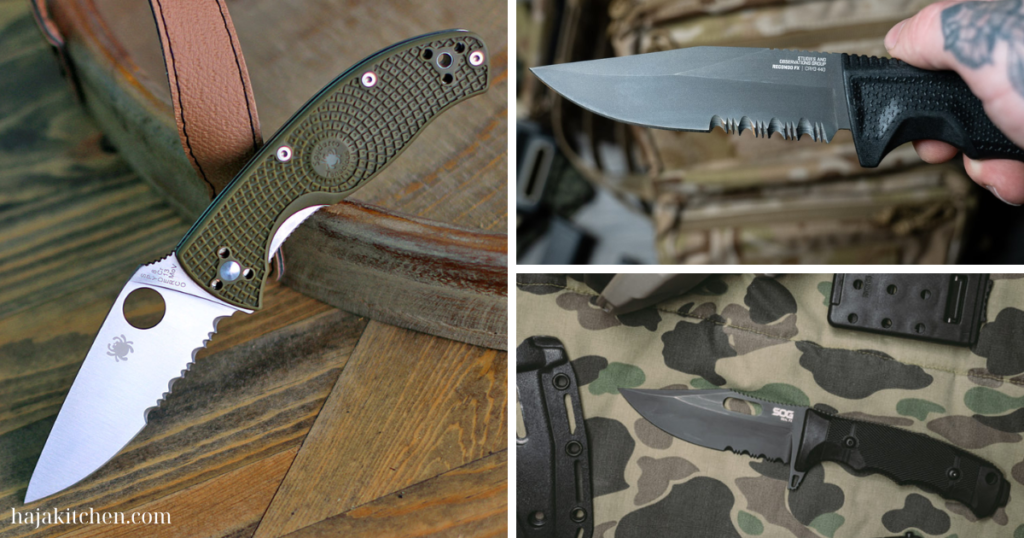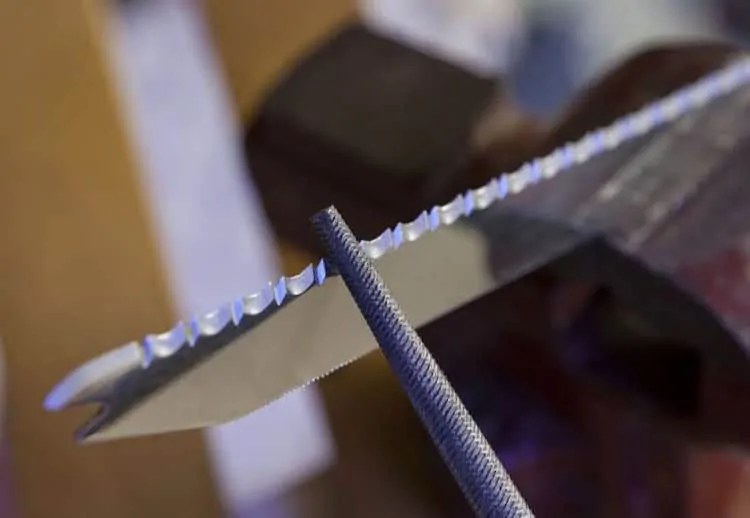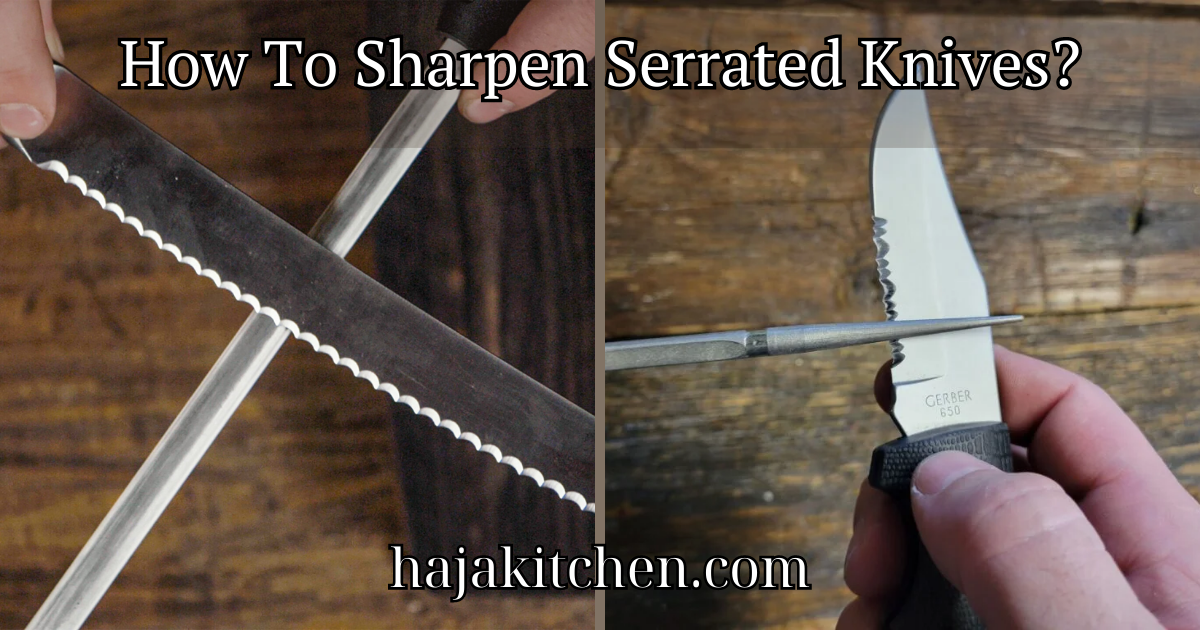Serrated knives are an essential kitchen tool that many of us use daily. But the serrations can become dull over time, making it difficult to cut through foods. Sharpening a serrated knife differs from the approach to a traditional straight-edge knife. This article will educate you on how to sharpen serrated knives and keeping them in top condition for all your kitchen needs.
Understand the Anatomy of a Serrated Knife
Before sharpening a serrated knife, learn its anatomy. Serrated blades have small, jagged teeth along the edge.
There are two main types of serrated knives: fully and partially serrated. Let’s elaborate on the characteristics and uses of each type:
1. Fully serrated knives

A fully serrated knife is a versatile and specialized cutting tool designed with serrations along the entire length of one or both sides. These serrations consist of small, scalloped, or jagged teeth. They enhance the knife’s cutting performance and efficiency in various situations.
Fully serrated knives are available in various sizes and styles. They range from folding pocket knives for everyday carry to more extensive fixed blades. Their unique design and cutting capabilities make them valuable to any outdoor toolkit.
The primary advantage of a fully serrated knife lies in its ability to grip and tear through rigid materials with ease. The serrations act like miniature saw teeth. They allow the knife to penetrate surfaces that might resist a plain-edged blade. It cuts fibrous or textured materials (rope, webbing, cardboard, foam) and even tough-skinned fruits and vegetables.
Additionally, fully serrated knives serve longer compared to plain-edged knives. Even if some of the serrations become dull due to heavy use, the rest of the blade remains sharp. It ensures continued performance in demanding situations.
Limitations:
- Fully serrated knives are not well-suited for tasks that require precise slicing or push cutting. The saw-like action may cause tearing or uneven cuts when dealing with softer materials or delicate food items.
- Special sharpening tools or professional sharpening services may be needed.
2. Partially serrated knives

A partially serrated knife, also known as a combo-edged knife, combines a section of serrations near the base of the blade with a plain edge closer to the tip. The serrated area typically extends from the base for a few centimeters or inches, leaving the remainder of the blade with a straight, plain edge.
The combination of serrated and plain edges makes partially serrated knives versatile, offering the advantages of both types. The serrated section handles rigid materials, while the plain section allows for more controlled slicing and precision.
Then, partially serrated knives are favored by many as EDC (Everyday Carry) tools for various daily tasks, from cutting fruits and vegetables to opening packages and handling household chores.
Limitations:
- Sharpening Complexity: Sharpening a partially serrated knife can be more complicated than sharpening a fully serrated or plain-edged knife. Properly sharpening both the serrated and plain sections requires specific techniques and tools.
- Trade-offs: While partially serrated knives offer versatility, they may excel less in specific specialized tasks than fully serrated or plain-edged knives. Users should consider their particular needs when choosing between different knife types.
Ultimately, the choice between fully-serrated and partially-serrated knives depends on the user’s intended use and personal preferences. Both types have unique advantages and limitations, catering to different cutting requirements and situations.
What to consider before sharpening serrated knives?

Before sharpening serrated knives, it is essential to consider the type of serrations, as different jagged edges may require specific sharpening methods or tools. Additionally, understanding the level of dullness and the desired sharpness is crucial, as overly aggressive sharpening can damage the serrations, impacting the knife’s cutting performance.
Choose the Right Sharpening Tool
When it comes to sharpening a serrated knife, using the right tool is crucial. You can either use a serrated knife sharpener, a honing rod, or a sharpening stone. A serrated knife sharpener is specially designed to sharpen serrated knives. In contrast, a honing rod is perfect for straightening and maintaining the blade’s edge. A sharpening stone can also be used, requiring more skill and practice.
Determine the Angle of the Serrations
The angle of the serrations on a serrated knife can vary depending on the manufacturer. Determining the pitch before you begin to sharpen the knife is essential. Most serrated knives have a bevel angle between 10 and 20 degrees.
Begin Sharpening
To begin sharpening, hold the sharpening tool against the serrated edge of the knife, making sure to match the angle of the serrations. Using light pressure, run the tool along the edge of the serrations, starting from the base of the blade and working your way towards the tip. Repeat this process for each serration, being careful not to over-sharpen or remove too much metal.
Hone the Blade
After you have sharpened the serrated edge, it is vital to hone the blade. Use a honing rod to straighten and realign the blade’s edge, which will help to maintain the serrations’ sharpness. Hold the honing rod against the blade at the same angle as the serrations and run it along the length of the blade.
Test the Knife
Testing the knife’s sharpness is essential once you have finished sharpening and honing the blade. Gently run the edge through a piece of paper or tomato skin. The knife is sharp and ready to use if it cuts cleanly and smoothly.
Clean and Store the Knife
After using the knife, cleaning and storing it properly is essential. Wash the knife by hand with warm soapy water and dry it thoroughly with a clean towel. Store the knife in a safe and secure location, away from other sharp objects.
Is it better to contact a professional knife sharpener?

Whether to contact a professional knife sharpener or attempt sharpening yourself depends on your comfort level, experience, and the condition of the serrated knife. Here are some factors to consider:
1. Skill and Experience
Sharpening a serrated knife requires a different approach than sharpening a plain-edged knife. If you lack experience or are unsure about the process, it may be better to seek the expertise of a professional knife sharpener with the necessary skills and knowledge.
2. Specialized Tools
Properly sharpening serrated knives requires specialized tools, such as tapered diamond rods or ceramic sharpening stones designed for serrations. If you don’t have access to these tools or aren’t familiar with their usage, a professional can ensure the correct equipment is used for the job.
3. Knife Value
If the serrated knife holds sentimental or monetary value, or if it is a high-quality, expensive knife, entrusting it to a professional sharpener can reduce the risk of accidental damage.
4. Severely Dull Serrations
Restoring dull or damaged serrations is better with suitable expertise. A professional sharpener can assess the knife’s condition and determine the best action.
5. Convenience and Time
Sharpening a serrated knife can be time-consuming and requires patience. A professional service may be more convenient if you prefer a quick, hassle-free solution.
However, if you enjoy sharpening knives and have experience with this task, you can attempt to sharpen the knife yourself. There are sharpening kits and tools designed for serrated knives. Then, follow proper techniques to avoid causing damage to the blade.
In summary, contacting a professional knife sharpener is a safe option. Especially if you are still determined about sharpening serrated knives or need more tools, a professional can provide expert care and help maintain the knife’s performance and longevity.
Conclusion
Sharpening a serrated knife may seem intimidating at first, but with the right tools and technique, it can be done quickly and easily. Remember to take your time, match the angle of the serrations, and use light pressure when sharpening. With some practice, you can keep your serrated knives in top condition for all your kitchen needs.
FaQ
Q: How often should I sharpen my serrated knife?
It depends on how frequently you use it. If you use it regularly, it’s a good idea to sharpen it every 6-12 months. If you use it less frequently, you may only need to sharpen it once a year or less.
Q: Can I use a regular sharpening stone to sharpen a serrated knife?
Yes, you can use a sharpening stone to sharpen a serrated knife, but it requires a bit more skill and practice. It’s important to match the angle of the serrations and use light pressure when sharpening.
Q: Can I use an electric knife sharpener on a serrated knife?
It’s not recommended to use an electric knife sharpener on a serrated knife as it can damage the serrations. Instead, use a serrated knife sharpener or honing rod.
Q: How do I know if I’m sharpening the serrations correctly?
You can test the sharpness of the serrations by gently running the blade through a piece of paper or tomato skin. If it cuts cleanly and smoothly, then the serrations are sharp.

